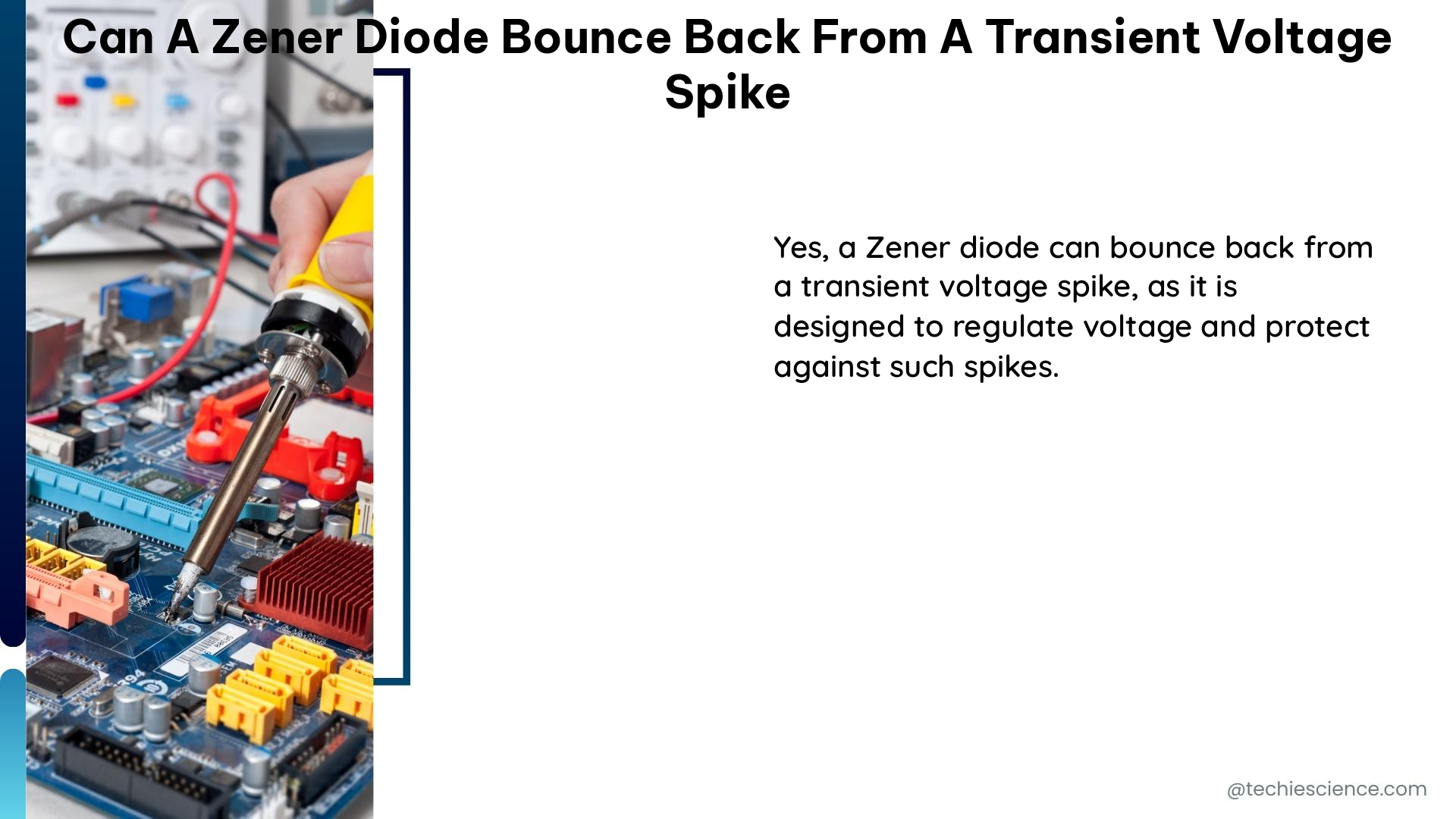Zener diodes are widely used in electronic circuits for voltage regulation and transient voltage suppression. Understanding their behavior under transient voltage spikes is crucial for ensuring reliable circuit operation. This comprehensive guide delves into the technical details of how Zener diodes respond to and recover from such voltage spikes.
Understanding Zener Diode Characteristics
- Zener Voltage (Vz): The voltage at which a Zener diode starts conducting in reverse bias. This voltage is specified in the diode’s datasheet and is a critical parameter for voltage regulation.
- Zener Knee Voltage: The voltage range where the Zener diode transitions from a high-impedance state to a low-impedance state. This voltage range is typically wider than the Zener voltage.
- Zener Impedance: The impedance of a Zener diode in its operating region. The impedance is typically higher for lower currents and lower for higher currents.
- Reverse Recovery Time: The time it takes for a diode to switch from conducting in reverse bias to blocking in reverse bias. This parameter is more relevant for regular diodes than for Zener diodes, as Zener diodes are typically used in reverse bias.
Zener Diode Behavior under Transient Voltage Spikes

- Overvoltage Protection:
- Zener diodes can provide overvoltage protection by clamping the voltage to their Zener voltage when the input voltage exceeds the Zener voltage.
- However, this protection is only effective if the Zener diode is rated for the maximum transient voltage expected. If the transient voltage is too high, the Zener diode may be damaged or destroyed.
-
For example, a Zener diode with a Vz of 12V can effectively clamp the voltage to 12V during a transient spike up to 15V. But if the spike exceeds 15V, the Zener diode may be damaged.
-
Temperature Effects:
- Zener diodes have a temperature coefficient that affects their Zener voltage. If the Zener diode is subjected to a transient voltage spike, it may heat up, causing its Zener voltage to change temporarily.
- For instance, a Zener diode with a temperature coefficient of -2 mV/°C will see its Zener voltage decrease by 20 mV if its temperature increases by 10°C during a transient spike.
-
If the spike is short, the Zener diode may recover and return to its original Zener voltage once it cools down.
-
Current Limiting:
- To protect the Zener diode from damage due to transient voltage spikes, it is essential to use a current-limiting resistor in series with the diode.
- The resistor ensures that the current through the diode does not exceed its maximum rated current during the spike.
-
For example, a Zener diode with a maximum rated current of 500 mA may require a 10Ω resistor in series to limit the current to 100 mA during a 15V transient spike.
-
Recovery Time:
- While reverse recovery time is not a primary concern for Zener diodes, as they are typically used in reverse bias, there may be some recovery time associated with switching from a high-current state to a low-current state.
- This recovery time may affect the Zener diode’s ability to regulate the voltage accurately during and after the transient spike.
- Typical Zener diode recovery times range from a few microseconds to a few milliseconds, depending on the diode’s design and operating conditions.
Quantifying Zener Diode Performance under Transient Spikes
To assess a Zener diode’s ability to withstand and recover from transient voltage spikes, you can perform the following tests:
- Transient Voltage Testing:
- Apply a transient voltage spike to the Zener diode and measure the voltage across it using an oscilloscope.
- The spike should be short (in the order of microseconds) and have an amplitude higher than the Zener voltage.
-
Repeat the test for different spike amplitudes and durations to determine the Zener diode’s voltage clamping capabilities.
-
Current Limiting Testing:
- Measure the current through the Zener diode during the transient voltage spike using a current probe or a shunt resistor.
-
Compare the measured current with the Zener diode’s maximum rated current to ensure the diode is not subjected to excessive current during the spike.
-
Temperature Testing:
- Measure the temperature of the Zener diode during and after the transient voltage spike using a thermal camera or a thermocouple.
-
Compare the measured temperature with the Zener diode’s maximum rated temperature to ensure the diode does not overheat during the spike.
-
Recovery Time Testing:
- Measure the Zener diode’s voltage regulation accuracy before and after the transient voltage spike using a voltage probe or a multimeter.
- Compare the measured voltage with the Zener voltage and calculate the recovery time based on the time it takes for the voltage to stabilize.
By performing these tests, you can quantify the Zener diode’s ability to withstand and recover from transient voltage spikes, ensuring the diode’s reliability and performance in your electronic circuits.
Conclusion
In summary, a Zener diode can withstand and recover from transient voltage spikes if it is rated for the maximum transient voltage expected, if a current-limiting resistor is used in series with the diode, and if the diode’s temperature and recovery time are within the manufacturer’s specifications. By understanding the Zener diode’s characteristics and performing the necessary tests, you can ensure the reliable operation of your electronic circuits under transient voltage conditions.
References:
– Zener Diode Characteristics and Applications
– Transient Voltage Suppression Using Zener Diodes
– Zener Diode Behavior Under Transient Conditions

The lambdageeks.com Core SME Team is a group of experienced subject matter experts from diverse scientific and technical fields including Physics, Chemistry, Technology,Electronics & Electrical Engineering, Automotive, Mechanical Engineering. Our team collaborates to create high-quality, well-researched articles on a wide range of science and technology topics for the lambdageeks.com website.
All Our Senior SME are having more than 7 Years of experience in the respective fields . They are either Working Industry Professionals or assocaited With different Universities. Refer Our Authors Page to get to know About our Core SMEs.